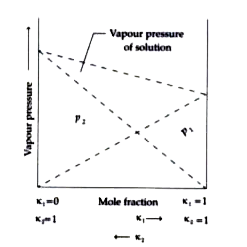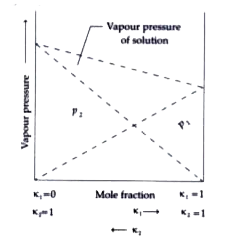Dalton's Law of Partial Pressure
Step by step video solution for Dalton's Law of Partial Pressure by Physics experts to help you in doubts & scoring excellent marks in Class 11 exams.
Updated on:21/07/2023Topper's Solved these Questions
Similar Questions
Out of the three stes of matter, only the gases have most of the physical properties common. They neither have definite shapes nor volumes. Upon mixing they form hoogeneous mixture irespective of their nature and can also be compressed on applying pressure. In addition to these, the gases obey different gas laws such as Noyle's Law, Charles's Law, Dalton's Law of partial pressures, Graham's Law of diffusion etc. Based upon these laws, ideal gas equation PV=nRT has been derived.
4-4 g of a gas at STP occupies a volume of 2.224 L. The gas can be :
View SolutionOut of the three stes of matter, only the gases have most of the physical properties common. They neither have definite shapes nor volumes. Upon mixing they form hoogeneous mixture irespective of their nature and can also be compressed on applying pressure. In addition to these, the gases obey different gas laws such as Noyle's Law, Charles's Law, Dalton's Law of partial pressures, Graham's Law of diffusion etc. Based upon these laws, ideal gas equation PV=nRT has been derived.
Which pair of gaseous species diffuse through a small jet with the same rate of diffusion at same P and T ?
View Solution
Knowledge Check
Out of the three stes of matter, only the gases have most of the physical properties common. They neither have definite shapes nor volumes. Upon mixing they form hoogeneous mixture irespective of their nature and can also be compressed on applying pressure. In addition to these, the gases obey different gas laws such as Noyle's Law, Charles's Law, Dalton's Law of partial pressures, Graham's Law of diffusion etc. Based upon these laws, ideal gas equation PV=nRT has been derived.
Same mass of CH4 and H2 at taken in a container. The partial pressure caused by H2 isA89B19C12D1Out of the three stes of matter, only the gases have most of the physical properties common. They neither have definite shapes nor volumes. Upon mixing they form hoogeneous mixture irespective of their nature and can also be compressed on applying pressure. In addition to these, the gases obey different gas laws such as Noyle's Law, Charles's Law, Dalton's Law of partial pressures, Graham's Law of diffusion etc. Based upon these laws, ideal gas equation PV=nRT has been derived.
When the produce of pressure and volume is plotted against pressure for a given amount of a gas, the obtained isAparallel to X-axisBparallel to Y-axisClinear with positive slopeDlinear with negative slopeOut of the three stes of matter, only the gases have most of the physical properties common. They neither have definite shapes nor volumes. Upon mixing they form hoogeneous mixture irespective of their nature and can also be compressed on applying pressure. In addition to these, the gases obey different gas laws such as Noyle's Law, Charles's Law, Dalton's Law of partial pressures, Graham's Law of diffusion etc. Based upon these laws, ideal gas equation PV=nRT has been derived.
For an ideal gas, number of moles per litre in terms of its pressuure P, gas constant R and temperature T is :APT/RBPRTCP/RTDRT/P
Assertion: If H2 and Cl enclosed separately in the same vessel exert pressure of 100 and 200mm respectively, their mixture in the same vessel at the same temperature will exert a pressure of 300mm
Reason: Dalton's law of partial pressures states that total pressure is the sum of partial pressures.
View SolutionRead the passage given below and answer the following questions :
Raoult's law states that for a solution of volatile liquids, the partial vapour pressure of each component of the solution is directly proportional to its mole fraction present in solution. Dalton's law of partial pressure states that the total pressure Ptotal over the solution phase in the container will be the sum of the partial pressures of the components of the solution and is given as:
Ptotal= P1+ P2

What type of deviation from Raoult's law does the above graph represent ?
View SolutionRead the passage given below and answer the following questions :
Raoult's law states that for a solution of volatile liquids, the partial vapour pressure of each component of the solution is directly proportional to its mole fraction present in solution. Dalton's law of partial pressure states that the total pressure Ptotal over the solution phase in the container will be the sum of the partial pressures of the components of the solution and is given as:
Ptotal= P1+ P2

Which of the following aqueous solutions should have the highest boiling point ?
View SolutionThe total pressure exerted in ideal binary solution is given by P=P∘AXA+P∘BXB where P∘A&P∘B are the respective vapour pressure of pure components and XA&XB are their mole fraction in liquid phase. And composition of the vapour phase is determined with the help of Dalton's law of partial pressure. YA=P∘AXAP
If total pressure exerted in an ideal binary solution is given by P=540060+30YAmm of Hg.
The value of P∘A is
View SolutionThe total pressure exerted in ideal binary solution is given by P=P∘AXA+P∘BXB where P∘A&P∘B are the respective vapour pressure of pure components and XA&XB are their mole fraction in liquid phase. And composition of the vapour phase is determined with the help of Dalton's law of partial pressure. YA=P∘AXAP
If total pressure exerted in an ideal binary solution is given by P=540060+30YAmm of Hg.
The more volatile liquid is
View Solution
